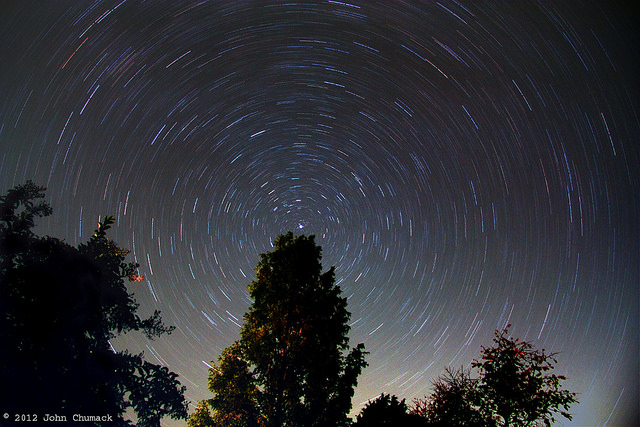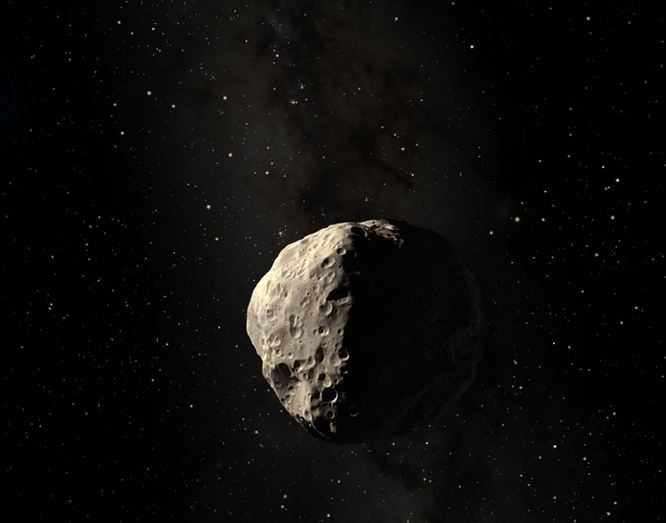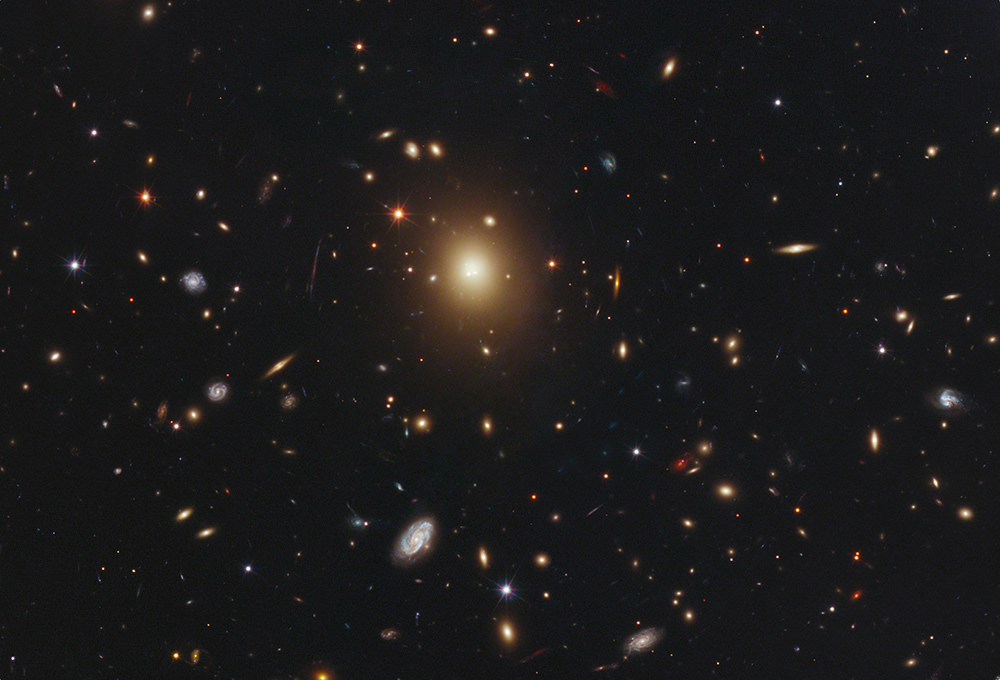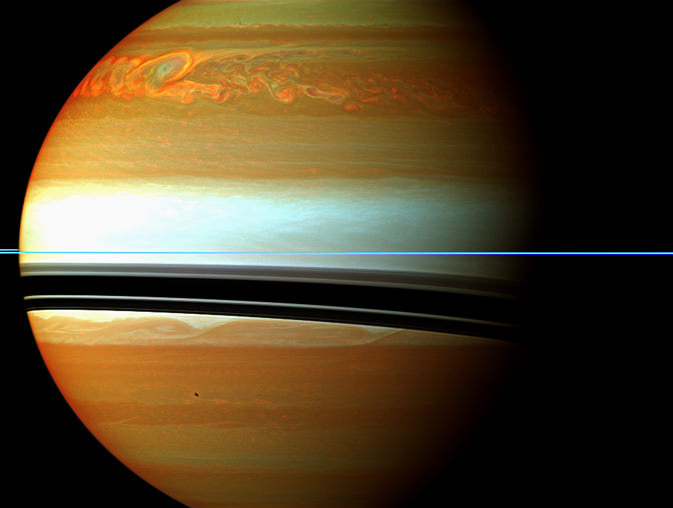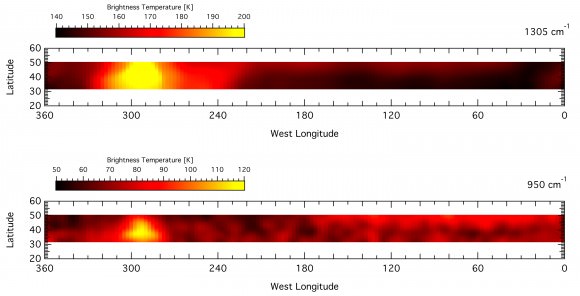This video shows various views of the Dragon capsule being unberthed and moving away from the International Space Station, and is sped up at 15 times actual speed. The kicker comes at the end with a look back at the ISS. Not quite as good a view as the old space shuttle flyarounds, but nice to see the station as a whole.
SpaceX’s Dragon Splashes Down Safely
The Dragon capsule after splashing down successfully on October 28, 2012. Credit: SpaceX
After leaving the International Space Station earlier on Sunday, SpaceX’s Dragon capsule returned to Earth from the International Space Station, safely splashing down in the Pacific Ocean about 400 kilometers (250 miles) off the coast of southern California. Inside the capsule are 758 kg (1,673 pounds) of return cargo including hardware, supplies, and a GLACIER freezer packed with scientific samples, including blood and urine samples of the astronauts on the space station, being returned for medical analysis. Currently, Dragon is the only craft capable of returning a significant amount of supplies to Earth, and this mission marks the first time since the retirement of the space shuttle that NASA has been able to return research samples for analysis.
Both NASA and SpaceX were thrilled with the success of the mission.
“This historic mission signifies the restoration of America’s ability to deliver and return critical space station cargo,” said SpaceX CEO and Chief Technical Officer Elon Musk. “The reliability of SpaceX’s technology and the strength of our partnership with NASA provide a strong foundation for future missions and achievements to come.”
NASA Administrator Charles Bolden added his congratulations to SpaceX: “Just a little over one year after we retired the Space Shuttle, we have completed the first cargo resupply mission to the International Space Station. Not with a government owned and operated system, but rather with one built by a private firm — an American company that is creating jobs and helping keep the U.S. the world leader in space as we transition to the next exciting chapter in exploration. Congratulations to SpaceX and the NASA team that supported them and made this historic mission possible.”
Raw video footage of the Dragon splashing down:
The SpaceX recovery team is now transporting Dragon by boat to a port near Los Angeles, where early cargo will be delivered to NASA. Dragon then will be transported to SpaceX’s facility in McGregor, Texas for processing. There, the remaining cargo will be delivered to NASA.
After a successful test flight in May of this year, this was the first “official” resupply mission for SpaceX to the ISS. The Dragon was launched on October 7 and reached the ISS three days later.
“It was nice while she was on board,” station commander Suni Williams radioed to back to Mission Control after the spacecraft was unberthed Sunday. “Literally and figuratively, there is a piece of us on that spacecraft going home to Earth.”
NASA Video of the Dragon capsule leaving the ISS:
The flight didn’t go with a hitch, however. An anomaly occurred with one of Falcon 9’s first-stage engines during the launch, and while it didn’t affect the mission to the ISS, a satellite that tagged along on the flight, the ORBCOMM OG2 prototype communications satellite, was delivered to the wrong orbit and ultimately fell back to Earth.
SpaceX and NASA are investigating the anomaly and analysis to date supports initial findings: the engine experienced a rapid loss of pressure and Falcon 9’s flight computer immediately commanded shutdown, as it is designed to do in such cases. SpaceX said they will continue to analyze all data in an effort to determine root cause and will apply those findings to future flights.
The next resupply mission for Dragon is tentatively scheduled for January 2013. Additionally, Orbital Sciences Corp, NASA’s second cargo hauler, plans to launch the first Cygnus capsule in February or March 2013.
Dragon floating down on parachutes. Credit: SpaceX
Weekly SkyWatcher’s Forecast: October 29 – November 4, 2012
Greetings, fellow SkyWatchers! Are you ready for some spooky targets this week? Then follow along as we take a look at the “Little Eyes”, the “Skull Nebula” and a star that’s as red as a drop of blood! If the weather permits, we’ll also be enjoying the Taruid Meteor Shower! Time to dust off those optics and meet me in the backyard…
Monday, October 29 – October’s Full Moon is known as the “Hunter’s Moon” or the “Blood Moon,” its name came from a time when hunters would stalk the fields by Luna’s cold light in search of prey before the winter season began. Pick a place at sunset to watch it rise – a place having a stationary point with which you can gauge its progress. Make note of the time when the first rim appears and then watch how quickly it gains altitude! How long does it take before it rises above your marker?
On this night in 1749, the French astronomer Le Gentil was at the eyepiece of an 18? focal length telescope. His object of choice was the Andromeda Galaxy, which he believed to be a nebula. Little did he know at the time that his descriptive notes also included M32, a satellite galaxy of M31. It was the first small galaxy discovered, and it would be another 175 years before these were recognized as such by Edwin Hubble.
Even though it’s very bright tonight, take the time to view the Andromeda Galaxy for yourself. Located just about a degree west of Nu Andromeda, this ghost set against the starry night was known as far back as 905 AD, and was referred to as the “Little Cloud.” Located about 2.2 million light-years from our solar system, this expansive member of our Local Galaxy Group has delighted observers of all ages throughout the years. No matter if you view with just your eyes, a pair of binoculars or a large telescope, M31 still remains one of the most spectacular galaxies in the night.
Tuesday, October 30 – Tonight let’s have a look at the big, fat Moon as we return again with binoculars to identify the maria once again. Take the time to repeat the names to yourself and to study a map. One of the keys to successfully learning to identify craters is by starting with large, easily recognized features. Even though the Moon is very bright when full, try using colored or Moon filters with your telescope to have a look at the many surface features which throw amazing patterns across its surface. If you have none, a pair of sunglasses will suffice.
Look for things you might not ordinarily notice – such as the huge streak which emanates from crater Menelaus. Look at the pattern projected from Proclus – or the intense little dot of little-known Pytheas north of Copernicus. It’s hard to miss the blinding beacon of Aristarchus! Check the southeastern limb where the edge of Furnerius lights up the landscape…or how a nothing crater like Censorinus shines on the southeast shore of Tranquillitatis, while Dionysus echoes it on the southwest. Could you believe Manlius just north of central could be such a perfect ring – or that Anaxagoras would look like a northern polar cap? On the eastern limb we see the bright splash ray patterns surrounding ancient Furnerius – yet the rays themselves emanate from the much younger crater Furnerius A. All over the visible side, we see small points light up: a testament to the Moon’s violent past written in its scarred lines. Take a look now at the western limb…for the sunrise is about to advance around it.
Wednesday, October 31 – Happy Halloween! Many cultures around the world celebrate this day with a custom known as “Trick or Treat.” Tonight instead of tricking your little ghouls and goblins, why not treat them to a sweet view through your telescope or binoculars? What Halloween would be complete without a witch?! Easily found from a modestly dark site with the unaided eye, the Pleiades can be spotted well above the northeastern horizon within a couple of hours of nightfall. To average skies, many of the 7 bright components will resolve easily without the use of optical aid, but to telescopes and binoculars? M45 (Right Ascension: 03 : 47.0 – Declination: +24 : 07) is stunning…
First let’s explore a bit of history. The recognition of the Pleiades dates back to antiquity and its stars are known by many names in many cultures. The Greeks and Romans referred to them as the “Starry Seven,” the “Net of Stars,” “The Seven Virgins,” “The Daughters of Pleione,” and even “The Children of Atlas.” The Egyptians referred to them as “The Stars of Athyr,” the Germans as “Siebengestiren” (the Seven Stars), the Russians as “Baba” after Baba Yaga, the witch who flew through the skies on her fiery broom. The Japanese call them “Subaru,” Norsemen saw them as packs of dogs and the Tonganese as “Matarii” (the Little Eyes). American Indians viewed the Pleiades as seven maidens placed high upon a tower to protect them from the claws of giant bears, and even Tolkien immortalized the stargroup in “The Hobbit” as “Remmirath.” The Pleiades have even been mentioned in the Bible! So, you see, no matter where we look in our “starry” history, this cluster of seven bright stars has been part of it. But, let’s have some Halloween fun!
The date of the Pleiades culmination (its highest point in the sky) has been celebrated through its rich history by being marked with various festivals and ancient rites – but there is one particular rite that really fits this occasion! What could be more spooky on this date than to imagine a group of Druids celebrating the Pleiades’ midnight “high” with Black Sabbath? This night of “unholy revelry” is still observed in the modern world as “All Hallow’s Eve” or more commonly as Halloween. Although the actual date of the Pleiades midnight culmination is now on November 21 instead of October 31, why break with tradition? Thanks to its nebulous regions, M45 looks wonderfully like a “ghost” haunting the starry skies.
Treat yourself and your loved ones to the “scariest” object in the night. Binoculars give an incredible view of the entire region, revealing far more stars than are visible with the naked eye. Small telescopes at lowest power will enjoy M45?s rich, icy-blue stars and fog-like nebulosity. Larger telescopes and higher power reveal many pairs of double stars buried within its silver folds. No matter what you choose, the Pleiades definitely rock!
Thursday, November 1 – On this day in 1977, Charles Kowal made a wild discovery – Chiron. This represented the first discovery of a multitude of tiny, icy bodies that lie in the outer reaches of our solar system. Collectively known as Centaurs, they reside in unstable orbits between Jupiter and Neptune and are almost certainly “refugees”” from the Kuiper Belt.
Tonight let’s go for something small, but white-hot as we head for a dwarf star and planetary nebula, NGC 246. You’ll find it just a bit more than a fistwidth north-northeast of Beta Ceti (RA 00 47 03.34 Dec -11 52 18.9).
First discovered by Sir William Herschel and cataloged as object V.25, this 8th magnitude planetary nebula has a wonderful patchy, diffuse structure that envelops four stars. Around 1600 light-years away, the nebulosity you can see around the exterior edges was once the outer atmosphere of a star much like our own Sun. At the center of the nebula lies the responsible star – the fainter member of a binary system. While it is now in the process of becoming a white dwarf, we can still enjoy the product of this expanding shell of gas that is often called the “Skull Nebula.”
Friday, November 2 – Celestial scenery alert! If you’re up when the Moon rises, be sure to look for the close pairing of Jupiter and the Moon – they’re only about a fingerwidth apart! For a few viewers in the southernmost Africa region, this is an occultation event, so be sure to check resources for websites like IOTA which will give you times for locations in your area. What a great photographic opportunity… Clear skies!
Today celebrates the birth of an astronomy legend – Harlow Shapely. Born in 1885, the American-born Shapley paved the way in determining distances to stars, clusters, and the center of our Milky Way galaxy. Among his many achievements, Shapely was also the Harvard College Observatory director for many years. Today in 1917 also represents the night first light was seen through the Mt. Wilson 100? telescope.
Of course, Dr. Shapley spent his fair share of time on the Hooker telescope as well. One of his many points of study was globular clusters, their distance, and their relationship to the halo structure of our galaxy. Tonight let’s have a look at a very unusual little globular located about a fistwidth south-southeast of Beta Ceti and just a couple of degrees north-northwest of Alpha Sculptor (RA 00:52:47.5 Dec -26:35:24), as we have a look at NGC 288.
Discovered by William Herschel on October 27, 1785, and cataloged by him as H VI.20, the class X globular cluster blew apart scientific thinking in the late 1980?s as a study of perimeter globulars showed it to be more than 3 million years older than similar globulars – thanks to the color magnitude diagrams of Hertzsprung and Russell. By identifying both its blue and red branches, it was shown that many of NGC 288?s stars are being stripped away by tidal forces and contributing to the formation of the Milky Way’s halo structure. In 1997, three additional variable stars were discovered in this cluster.
At magnitude 8, this small globular is easy for southern observers, but faint for northern ones. If you are using binoculars, be sure to look for the equally bright spiral galaxy NGC 253 to the globular’s north.
Saturday, November 3 – On this day in 1955, one of the few documented cases of a person being hit by a meteorite occurred. What are the odds on that? In 1957 the Russian space program launched its first “live” astronaut into space – Laika. Carried on board Sputnik 2, our canine hero was the first living creature to reach orbit. The speedily developed Sputnik 2 was designed with sensors to transmit the ambient pressure, breathing patterns and heartbeat of its passenger, and also had a television camera on board to monitor its occupant. The craft also studied ultraviolet and x-ray radiation to further assess the impact of space flight upon live occupants. Unfortunately, the technology of the time offered no way to return Laika to Earth, so she perished in space. On April 14, 1958, Laika and Sputnik 2 returned to Earth in a fiery re-entry after 2,570 orbits.
Since we’ve got the scope out, let’s go have another look at that galaxy we spied last night!
Discovered by Caroline Herschel on September 23, 1783, NGC 253 (RA 00 47.6 Dec -25 17) is the brightest member of a concentration of galaxies known as the Sculptor Group, near to our own local group and the brightest of all outside it. Cataloged as both H V.1 and Bennett 4, this 7th magnitude beauty is also known as Caldwell 65, and due to both its brightness and oblique angle is often called the “Silver Dollar Galaxy.” As part of the SAC 110 best NGCs, you can even spot this one if you don’t live in the Southern Hemisphere. At around 10 million light-years away, this very dusty, star-forming Seyfert galaxy rocks in even a modest telescope!
Sunday, November 4 – This morning will be the peak of the Southern Taurid meteor shower. Already making headlines around the world for producing fireballs, the Taurids will be best visible in the early morning hours, but the Moon will interfere. The radiant for this shower is, of course, the constellation of Taurus and red giant Aldeberan, but did you know the Taurids are divided into two streams?
It is surmised that the original parent comet shattered as it passed our Sun around 20,000 to 30,000 years ago. The larger “chunk” continued orbiting and is known as periodic comet Encke. The remaining debris field turned into smaller asteroids, meteors and larger fragments that often pass through our atmosphere creating the astounding “fireballs” known as bolides. Although the fall rate for this particular shower is rather low at 7 per hour, these slow traveling meteors (27 km or 17 miles per second) are usually very bright and appear to almost “trundle” across the sky. With the chances high all week of seeing a bolide, this makes a bit of quiet contemplation under the stars worthy of a morning walk. Be sure to look at how close Saturn is to the Moon!
For unaided eye or binocular observers – or those who just wish something a bit “different” tonight – have a look at 19 Pisces. You’ll find it as the easternmost star in the small “circlet” just south of the Great Square of Pegasus.
Also known as TX, you’ll find this one quite delightful for its strong red color. TX is a cool giant star which varies slightly in magnitude on an irregular basis. This carbon star is located anywhere from 400 to 1000 light-years away and rivals even R Leporis’ crimson beauty.
Until next week? Wishing you clear skies!
Hurricane Sandy Barreling to Eastern Seaboard Menacing Millions
Image Caption: NOAA Satellite image of Hurricane Sandy threatening millions of people living along US Eastern Seaboard. See NASA satellite imagery below. Credit: NOAA
Hurricane Sandy, a powerfully monstrous and unprecedented late season storm, is barreling mightily towards the US Eastern Seaboard, menacing tens of millions of residents living in the path of her sustained destructive winds, rains and life threatening storm surges.
Mandatory mass evacuations involving hundreds of thousands of people are already in progress in anticipation of a devastating storm strike on Monday (Oct 29).
First effects from Sandy are expected on Sunday night (Oct 28) in the New York/ New Jersey/Connecticut/Pennsylvania metropolitan area. Wind gusts are already exceeding 40 MPH as of Sunday afternoon, here in New Jersey – and steadily worsening.
Coastal Wave heights of 6 to 11 feet are predicted – possibly breaking records.
Public transit systems in New York City/New York, New Jersey, Philadelphia, Pennsylvania, Connecticut and Washington, D.C. have been ordered to shut down later today – Sunday – by the Governors’ of the affected states. Most schools and government offices will also be closed on Monday.
Amtrak has just announced it will shutdown trains in the Northeast Corridor.
Image Caption: Hurricane Sandy off the southeastern United States was imaged at noon Eastern Daylight Time (16:00 UT) on October 28, 2012, acquired by the Moderate Resolution Imaging Spectroradiometer (MODIS) on NASA’s Terra satellite. Credit: NASA Terra satellite
As of Sunday afternoon (Oct. 28) Sandy is predicted to make a dramatic, sharp left hook on Monday morning and most likely will make a violent direct hit slamming somewhere along the Jersey shore which borders from Maryland to New York City and beyond – sending high waves surging into coastal towns and cities overwhelming protective barriers.
Image Caption: Predicted path of Hurricane Sandy. Credit: NOAA
Inland areas will also suffer widespread destruction and power losses as Sandy slowly moves onshore and lingers over an extraordinarily wide path spanning several hundred miles in diameter.
Heavy rains and hurricane force wind gusts will soak the ground, taking down trees and power lines. Leaves may block storm drains.
Hurricane Sandy is currently classified as a Category 1 Hurricane. Its effects could be catastrophic and should not be taken lightly.
Making matters even worse, Sandy will hit during a full moon and the astronomical highest tides.
The National Hurricane Service warns that major flooding effecting millions of homes and businesses is expected along the US East Coast stretching from North Carolina to New England.
Millions and millions of people have more than a 50% chance of losing power.
Local power companies learned hard lessons from the devastating effects of Hurricane Irene just 1 year ago, which caused widespread and serious misery, flooding and deaths throughout the Northeast. Some people went without power for more than 2 weeks in the aftermath of Hurricane Irene in 2011. This author lost power for several days and now we are in for another direct hit.
Additional Power crews have been called in from across the country and prepositioned as a precautionary measure. NEVER touch any downed power lines.
States of Emergency have been declared in 9 eastern States from North Carolina to Maine as well as the District of Columbia.
Mandatory evacuations of low lying coastal areas have been ordered by the Governors’ of New Jersey, New York and Connecticut. State Shelters are being opened now.
Ocean wave heights of 20 to 50 feet have already been reported near the Hurricane’s eye.
Even the US Presidential election is being affected by Hurricane Sandy. Campaign events by both candidates Obama and Romney have been cancelled in several key battleground states. It is possible that polling stations may lose power – and the consequences are unknown on the closely contested election that could hinge on a handful of votes !
Stay tuned to NOAA, NASA and local and national news for continuing Hurricane updates.
NASA Satellite Sees Ghostly Remains of Vanishing Arctic Sea Ice
Sea ice swirls in ocean currents off the coast of Greenland (NASA/GSFC)
Spooky spectral swirls of last season’s sea ice drift in currents off the coast of eastern Greenland in this image from NASA’s Aqua satellite, acquired on October 17. Although sea ice in the Arctic will start forming again after September’s record low measurements, these ghostly wisps are likely made up of already-existing ice that has migrated south.
As global temperatures rise — both over land and in the ocean — thinner sea ice builds up during the Arctic winter and thus more of it melts during the summer, a pattern that will eventually lead to an ice-free Arctic if trends continue. The past several years saw sea ice in the Arctic below the 1979-2000 average, with this past September displaying the lowest volumes yet recorded.
The graph below, made from data modeled by the Polar Science Center at the University of Washington, show the chilling — or, perhaps, not-so-chilling — results of this century’s recent observations.
Along Greenland’s east coast, the Fram Strait serves as an expressway for sea ice moving out of the Arctic Ocean. The movement of ice through the strait used to be offset by the growth of ice in the Beaufort Gyre.
Until the late 1990s, ice would persist in the gyre for years, growing thicker and more resistant to melt. Since the start of the twenty-first century, however, ice has been less likely to survive its trip through the southern part of the Beaufort Gyre. As a result, less Arctic sea ice has been able to pile up and form multi-year ice.
Thin, free-drifting ice — as seen above — moves very easily with winds and currents.
Aqua is a NASA Earth Science satellite mission named for the large amount of information that the mission is collecting about the Earth’s water cycle, including evaporation from the oceans, water vapor in the atmosphere, clouds, precipitation, soil moisture, sea ice, land ice, and snow cover on the land and ice. Aqua was launched on May 4, 2002, and carries six Earth-observing instruments in a near-polar low-Earth orbit. MODIS, which acquired the image above, is a 36-band spectroradiometer that measures physical properties of the atmosphere, oceans and land.
Source: NASA Earth Observatory
NASA image courtesy Jeff Schmaltz, LANCE MODIS Rapid Response Team at NASA GSFC. Graph by Jesse Allen based on modeled ice volume data from the Polar Science Center, University of Washington. Caption portions by Michon Scott with information from Ted Scambos, National Snow and Ice Data Center.
Astrophoto: Polaris and Circumpolar Rotation in 30 Minutes
This recent image from astrophotographer John Chumack shows the Earth’s natural rotation in just 30 minutes of exposure time. Polaris, the North Star, is the stationary point over a Sequoia tree in Warrenton, Virginia, USA. “The rotational speed of the Earth at the equator is about 1,038 miles per hour,” John writes. “At mid-latitudes, the speed of the Earth’s rotation decreases to 700 – 900 miles per hour. You can notice star trails “rotation” in your photographs even in as little as 1 minute exposures. I notice star trailing in about 30 seconds with a 17mm wide angle lens. But the longer you leave the shutter open the more trailing and the more dramatic the effect!”
John used a Canon Rebel Xsi, ISO 400, .17mm Lens at F4.
See more of his work at his website, Galactic Images.
Want to get your astrophoto featured on Universe Today? Join our Flickr group or send us your images by email (this means you’re giving us permission to post them). Please explain what’s in the picture, when you took it, the equipment you used, etc.
Deflecting Incoming Asteroids with Paintballs
An artist’s rendering of the asteroid Apophis. Credit: ESA
What would be a way to deflect asteroid Apophis if it gets a little too close for comfort in 2029 or 2036? Pew-pew it with 5 tons of white paintballs. Not only would the multiple mini impacts bump the asteroid off course, but the white paint would cover the surface and reflect more sunlight, and over time, the bouncing of photons off its surface could create enough of a force to push the asteroid off its course.
That’s the idea of the winning entry in this year’s Move an Asteroid Technical Paper Competition, sponsored by the United Nations’ Space Generation Advisory Council. Sung Wook Paek, a graduate student in MIT’s Department of Aeronautics and Astronautics, says if timed just right, pellets full of paint powder, launched in two rounds from a spacecraft at relatively close distance, would cover the front and back of an asteroid, more than doubling its reflectivity, or albedo. The initial force from the pellets would bump an asteroid off course; over time, the sun’s photons would deflect the asteroid even more.
This video portrays how the paintball technique would work:
There have been lots of ideas put forth for possible asteroid deflection, such as using a gravity tractor to pull it off course, hitting it with a projectile or spacecraft to move it, or attaching a solar sail to change its course, to name a few.
Paek said his paintball strategy builds on a solution submitted by last year’s competition winner, who proposed deflecting an asteroid with a cloud of solid pellets. Paek came up with a similar proposal, adding paint to the pellets to take advantage of solar radiation pressure — the force exerted on objects by the sun’s photons.
In his proposal, Paek used the asteroid Apophis as a theoretical test case. This 27-gigaton rock may come close to Earth in 2029, and then again in 2036. Paek determined that five tons of paint would be required to cover the massive asteroid, which has a diameter of 450 meters (1,480 feet). He used the asteroid’s period of rotation to determine the timing of pellets, launching a first round to cover the front of the asteroid, and firing a second round once the asteroid’s backside is exposed. As the pellets hit the asteroid’s surface, they would burst apart, splattering the space rock with a fine, five-micrometer-layer of paint.
But this is not a quick-solution method, as Paek estimates that it would take up to 20 years for the cumulative effect of solar radiation pressure to successfully push the asteroid off its Earthbound trajectory. So if astronomers determine Apophis is a threat in 2029, we’re already too late. Additionally, the paintball method is not an option if estimates change for Asteroid 2012 DA14, which is predicted to pass very close to Earth on February 15, 2013, about 35,000 kilometers (21,000 miles) away.
Plus, using traditional paintballs, or traditional rockets for launching them, may not be ideal. Paek says the violent takeoff may rupture the payload. Instead, he envisions paintballs may be made in space, in ports such as the International Space Station, where a spacecraft could then pick up a couple of rounds of pellets to deliver to the asteroid.
But other substances could also be used instead of paint, such as aerosols that, when fired at an asteroid, “impart air drag on the incoming asteroid to slow it down,” Paek says. “Or you could just paint the asteroid so you can track it more easily with telescopes on Earth. So there are other uses for this method.”
Scientists have said the key to deflecting a dangerous asteroid is to find them early so that a plan can be developed. William Ailor, an asteroid specialist at Aerospace Corporation in California said that the potential for an asteroid collision is a long-term challenge for scientists and engineers.
“These types of analyses are really timely because this is a problem we’ll have basically forever,” Ailor says. “It’s nice that we’re getting young people thinking about it in detail, and I really applaud that.”
Source: MIT
On Again, Off Again Exoplanet Fomalhaut b is Back from the Dead
This visible-light image from the Hubble Space Telescope shows the vicinity of the star Fomalhaut, including the location of its dust ring and disputed planet, Fomalhaut b. A coronagraphic mask helped dim the star’s brightness. This view combines two 2006 observations that were taken with masks of different sizes (1.8 and 3 arcseconds). (Credit: NASA/ESA/T. Currie, U. Toronto)
Just in time for Halloween, astronomers are bringing an extrasolar planet back from the dead. Another look at the nearby star Fomalhaut reveals that a planet, named Fomalhaut b, is actually, really there, refuting a previous claim against its existence. In 2008, it was announced that a large, Saturn mass planet shepherded a large dust ring and was spotted in visual images from Hubble, and was said to be the first exoplanet ever directly imaged in visible light around another star. But in late 2011 infrared observations called the previous detections into question. A new analysis of data from Hubble, however, brings the planet conclusion back to life.
It’s like a zombie planet that just won’t die.
Fomalhaut is the brightest star in the constellation Piscis Austrinus and lies 25 light-years away.Originally, Fomalhaut b was estimated to be approximately the size of Saturn, and might even have rings. It resides within a debris ring which encircles the star Fomalhaut, located about 25 light-years away from Earth.
Then, later studies claimed that this planetary interpretation is incorrect. Based on the object’s apparent motion and the lack of an infrared detection by NASA’s Spitzer Space Telescope, they argued that the object is a short-lived dust cloud unrelated to any planet.
But still another observation brings this planet back.
“Although our results seriously challenge the original discovery paper, they do so in a way that actually makes the object’s interpretation much cleaner and leaves intact the core conclusion, that Fomalhaut b is indeed a massive planet,” said Thayne Currie, an astronomer formerly at NASA’s Goddard Space Flight Center in Greenbelt, Md., and now at the University of Toronto.
The discovery study reported that Fomalhaut b’s brightness varied by about a factor of two and cited this as evidence that the planet was accreting gas. Follow-up studies then interpreted this variability as evidence that the object actually was a transient dust cloud instead.
In the new study, Currie and his team reanalyzed Hubble observations of the star from 2004 and 2006. They easily recovered the planet in observations taken at visible wavelengths near 600 and 800 nanometers, and made a new detection in violet light near 400 nanometers. In contrast to the earlier research, the team found that the planet remained at constant brightness.
The team attempted to detect Fomalhaut b in the infrared using the Subaru Telescope in Hawaii, but was unable to do so. The non-detections with Subaru and Spitzer imply that Fomalhaut b must have less than twice the mass of Jupiter.
Another contentious issue has been the object’s orbit. If Fomalhaut b is responsible for the ring’s offset and sharp interior edge, then it must follow an orbit aligned with the ring and must now be moving at its slowest speed. The speed implied by the original study appeared to be too fast. Additionally, some researchers argued that Fomalhaut b follows a tilted orbit that passes through the ring plane.
Using the Hubble data, Currie’s team established that Fomalhaut b is moving with a speed and direction consistent with the original idea that the planet’s gravity is modifying the ring.
“What we’ve seen from our analysis is that the object’s minimum distance from the disk has hardly changed at all in two years, which is a good sign that it’s in a nice ring-sculpting orbit,” explained Timothy Rodigas, a graduate student in the University of Arizona and a member of the team.
Currie’s team also addressed studies that interpret Fomalhaut b as a compact dust cloud not gravitationally bound to a planet. Near Fomalhaut’s ring, orbital dynamics would spread out or completely dissipate such a cloud in as little as 60,000 years. The dust grains experience additional forces, which operate on much faster timescales, as they interact with the star’s light.
“Given what we know about the behavior of dust and the environment where the planet is located, we think that we’re seeing a planetary object that is completely embedded in dust rather than a free-floating dust cloud,” said team member John Debes, an astronomer at the Space Telescope Science Institute in Baltimore, Md.
A paper describing the findings has been accepted for publication in The Astrophysical Journal Letters.
And as we reported in April, another team using the Atacama Large Millimeter/sub-millimeter Array (ALMA) indicated they found evidence of Fomalhaut b, and maybe even more planets in the system, giving more credence to the planet’s exitence.
Because astronomers detect Fomalhaut b by the light of surrounding dust and not by light or heat emitted by its atmosphere, it no longer ranks as a “directly imaged exoplanet.” But because it’s the right mass and in the right place to sculpt the ring, Currie’s team thinks it should be considered a “planet identified from direct imaging.”
Fomalhaut was targeted with Hubble most recently in May by another team. Those observations are currently under scientific analysis and are expected to be published soon.
Source: NASA
Stirred, Not Shaken. Black Hole Antics Puff Up Whopper of a Galaxy
Its massive gravitational field warping space, the huge elliptical galaxy A2261-BCG, seems to have a diffuse halo of stars instead of a bright central galactic core. Image credit: NASA/ESA Hubble
Bloated far beyond the size of normal galaxies, one or more black holes may have puffed up an elliptical galaxy to a whopping size, according to astronomers. To their surprise, however, the black holes are missing.
Normally, scientists measure a concentrated peak of light surrounding the central black hole surrounded by a fuzzy halo of stars. Instead, astronomers, using NASA’s Hubble Space Telescope, find that the galaxy, known as A2261-BCG, is just a diffuse, bloated foggy patch of light. The intensity of starlight remains even across the entire galaxy. Past Hubble observations show supermassive black holes, each weighing billions of times more than our Sun, reside at the cores of nearly all galaxies.
“Expecting to find a black hole in every galaxy is sort of like expecting to find a pit inside a peach,” explained astronomer and co-author Tod Lauer in a press release. Lauer is with the National Optical Astronomy Observatory in Tucson, Ariz. “With this Hubble observation, we cut into the biggest peach and we can’t find the pit. We don’t know for sure that the black hole is not there, but Hubble shows that there’s no concentration of stars in the core.”
So where are the black holes?
Astronomers, in a paper that appeared in the September 10 issue of The Astrophysical Journal, have two ideas, both involving galactic billiards, for the galaxy’s puffy appearance. In one scenario, a pair of merging black holes gravitationally stir up then scatter the galaxy’s stars. In another, the merging black holes are ejected leaving the swarm of stars with no gravitational anchor allowing them to wander outward.
Galaxy cores tend to be sized proportionally to the wheeling expanse of the host galaxy. In the case of A2261-BCG, which spans about a million light-years (10 times that of our Milky Way Galaxy), the central region is three times larger than other very luminous galaxies, according to the paper. The monster galaxy is the most massive and brightest galaxy in the Abell 2261 galaxy cluster.
Team leader Marc Postman of the Space Telescope Science Institute in Baltimore, Md., said in the press release that the galaxy stood out in the Hubble image. “When I first saw the image of this galaxy, I knew right away it was unusual,” Postman explained. “The core was very diffuse and very large. The challenge was then to make sense of all the data, given what we knew from previous Hubble observations, and come up with a plausible explanation for the intriguing nature of this particular galaxy.”
The team admits the ejected black-hole ideas sound far-fetched, “but that’s what makes observing the universe so intriguing — sometimes you find the unexpected,” said Postman.
As a follow-up, the team is searching for the sound of material falling into the black hole using the Very Large Array (VLA) radio telescope in New Mexico. Comparing the VLA data with Hubble images will allow the researchers to confirm the existence of a black hole and map its location.
Source: Hubblesite
Giant “Invisible” Vortex Still Remains on Saturn Following Huge Storm
In 2010, a small, bright white storm emerged on Saturn’s northern hemisphere. This storm grew until it wrapped around the planet in curly cloud structures, creating a colossal atmospheric disturbance that endured into the early part of 2012, becoming the largest storm seen on the planet since 1990. Being in orbit around the ringed planet, the Cassini spacecraft had a front row seat to watch the disturbance unfold, allowing planetary scientists an unprecedented look at this monster storm. While the storm was visible even to amateur astronomers on Earth, much of its activity took place beyond the reach of visible-light cameras and telescopes, astronomers say. Not only did huge “beacons” of hot air chase each other around the planet, but infrared observations show a giant oval vortex is still persisting as a side effect from the storm.
“It’s the first time we’ve seen anything like it on any planet in the Solar System,” said Leigh Fletcher from the University of Oxford, UK, lead author of a paper describing the unprecedented storm. “It’s extremely unusual, as we can only see the vortex at infrared wavelengths – we can’t tell that it is there simply by looking at the cloud cover.”
Fletcher and her team also used ground-based observations with the Very Large Telescope of the European Southern Observatory in Chile, and NASA’s Infrared Telescope Facility at the summit of Mauna Kea in Hawaii.
As the visible storm erupted in the roiling cloud deck of Saturn’s troposphere, waves of energy rippled hundreds of kilometers upwards, depositing their energy as the two vast ‘beacons’ of hot air in the stratosphere.
Data from Cassini’s composite infrared spectrometer (CIRS) instrument revealed the storm’s powerful discharge sent the temperature in Saturn’s stratosphere soaring 65 degrees C (150 degrees Fahrenheit, 83 kelvins) above normal.
Researchers described in a complimentary paper that will be published in the Nov. 20 issue of the Astrophysical Journal this as a “belch” of energy, as they observed a huge increase in the amount of ethylene gas in Saturn’s atmosphere, the origin of which is a mystery. Ethylene, an odorless, colorless gas, isn’t typically observed on Saturn. On Earth, it is created by natural and man-made sources.
Researchers are still is exploring the origin of the ethylene, but they have ruled out a large reservoir deep in the atmosphere.
“We’ve really never been able to see ethylene on Saturn before, so this was a complete surprise,” said Goddard’s Michael Flasar, the CIRS team lead.
The beacons were expected to cool down and dissipate, but by late April 2011 – by which time bright cloud material had encircled the entire planet – the hot spots had merged to create an enormous vortex that for a brief period exceeded even the size of Jupiter’s famous Great Red Spot.
The forceful storm generated unprecedented spikes in temperature and increased amounts of ethylene. In these two sets of measurements taken by Cassini’s composite infrared spectrometer, yellow represents the highest temperatures. Each strip maps a single molecule (top: methane, bottom: ethylene), with temperature measurements taken in the northern hemisphere, all the way around the planet. Image credit: NASA/JPL-Caltech/GSFC
Although comparisons to Jupiter’s Red Spot have been made to this storm, Saturn’s storm was much higher in the atmosphere while Jupiter’s vortex is embedded deep down in the turbulent ‘weather zone’, Fletcher said.
Also, Jupiter’s famous vortex has raged for at least 300 years. But after traversing the planet once every 120 days since May 2011, Saturn’s large beacon is cooling and shrinking. Scientists expect it to fade away completely by the end of 2013.
The question now remains as to whether Saturn’s storm-generating energy has been sapped or if there will be a repeat performance, the team said.
The outburst already caught observers by surprise by arriving during the planet’s northern hemisphere spring, years ahead of the predictably stormy summer season.
“The beauty is that Cassini will be operating until the Saturn system reaches its summer solstice in 2017, so if there is another global event like this, we’ll be there to see it,” says ESA’s Cassini project scientist Nicolas Altobelli.

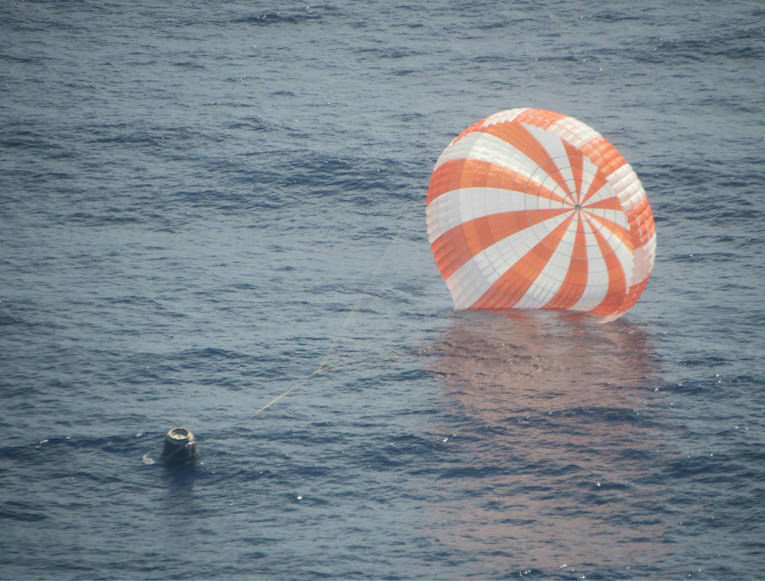
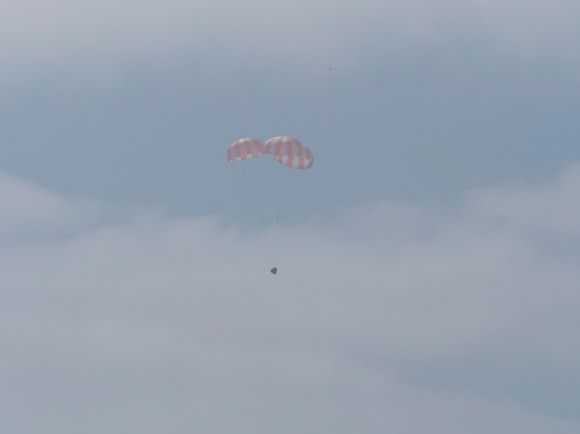
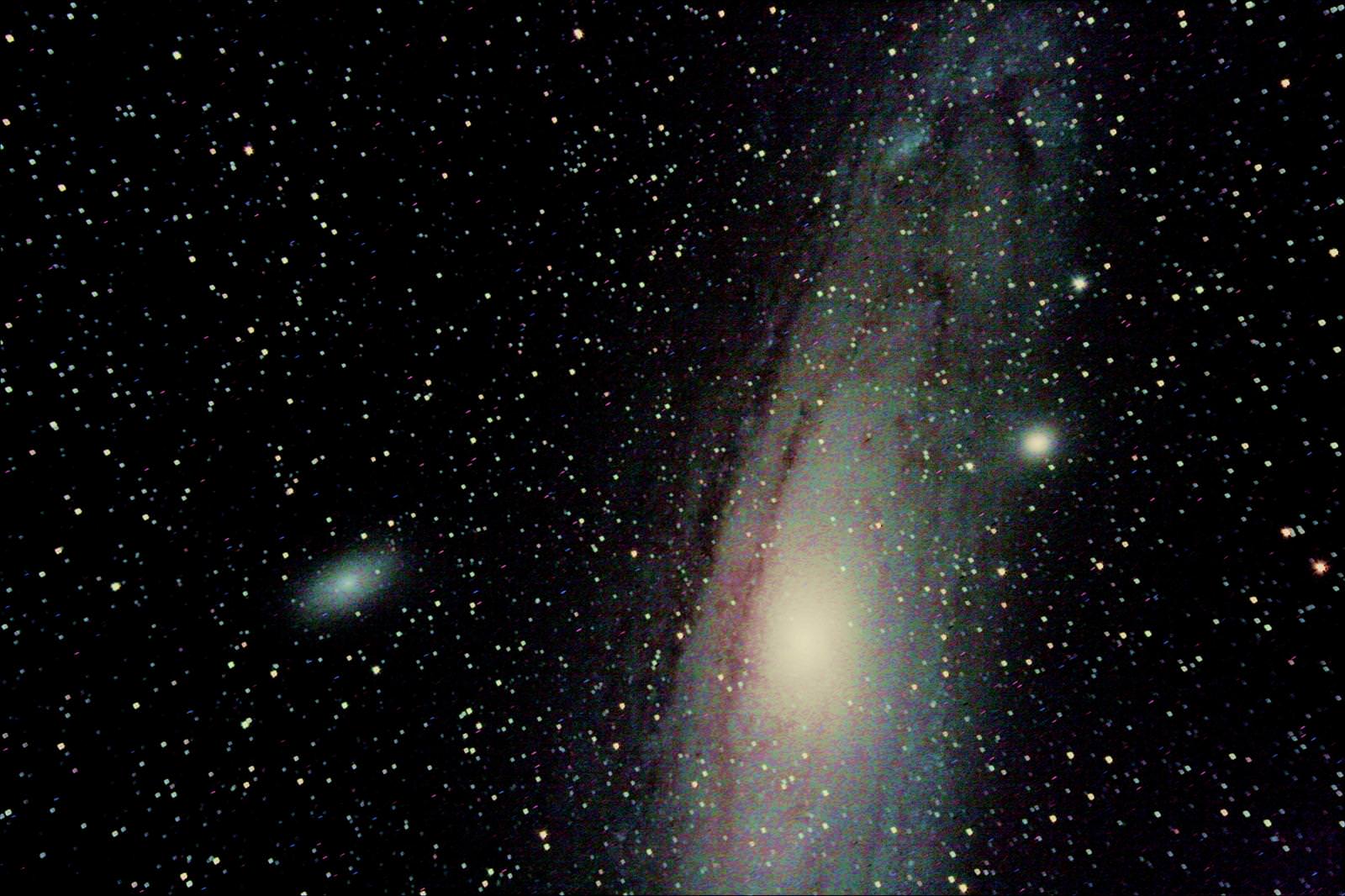
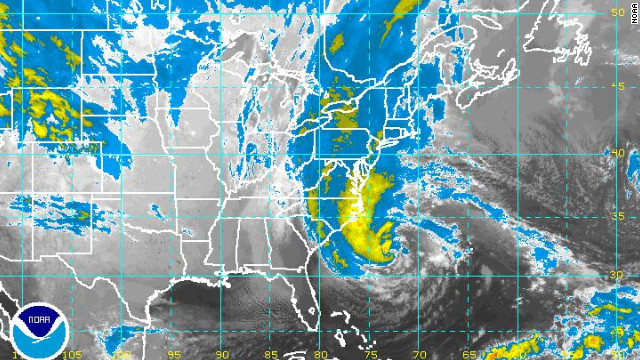
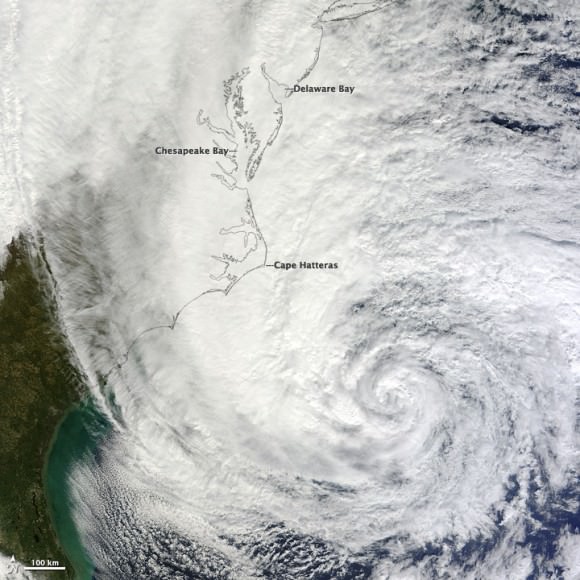
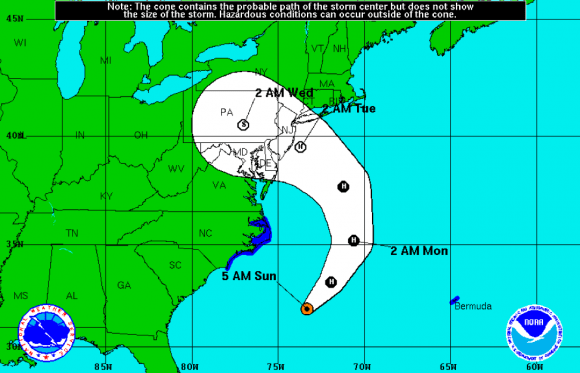
![Sandy_rainfall[1]](https://www.universetoday.com/wp-content/uploads/2012/10/Sandy_rainfall1-580x464.gif)



